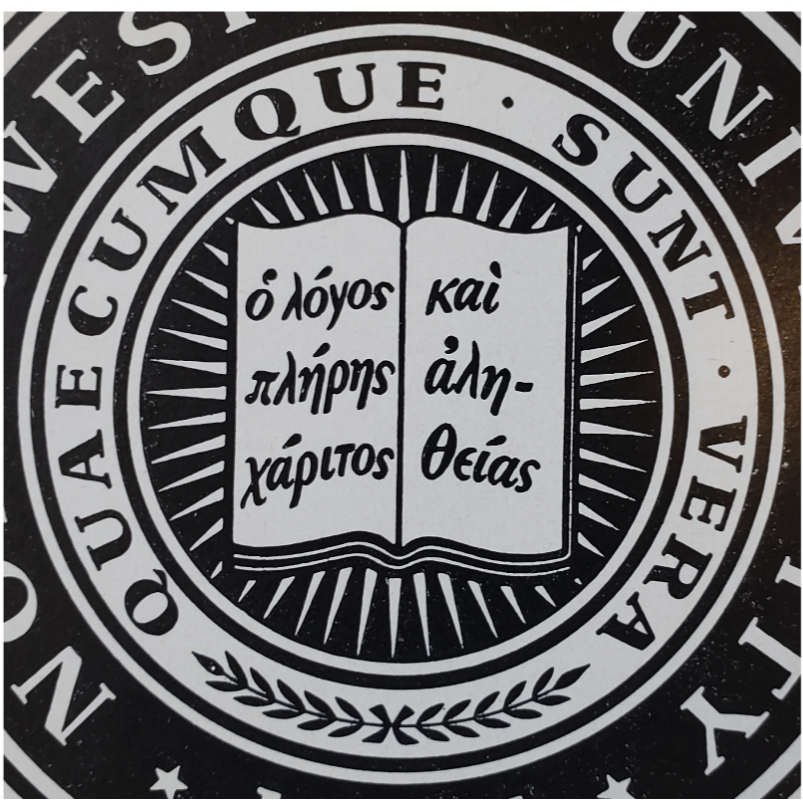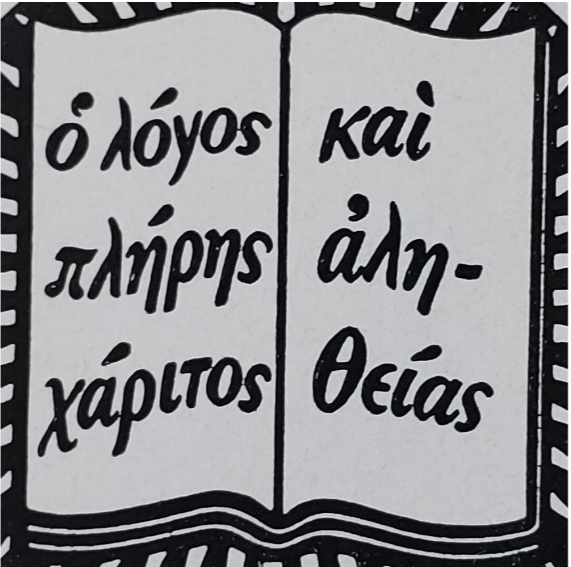

“University Seal & Motto; University Coat of Arms” collection, Northwestern University Archives, Evanston IL
One of the main sources of inspiration for the seal was the Holy Bible. Both verses featured on the seal come from it. The usage of the Bible may have been a product of founders who were strong leaders of the Methodist Church at the time, but the Bible itself is a source of classical antiquity. Originally written in Classical Hebrew, its first true translation was in Greek. The Bible itself is a library of stories, poems, songs, history, letters, and religious literature which is broken into two parts: the Old and the New Testament. The Old Testament, which is the original Hebrew Bible, was written over a long period of time from approximately 1200 to 165 BC. The New Testament was written by Christians in the first century AD. All of the Bible was eventually written in Greek as it was the common language of the Eastern Mediterranean. Despite the common reception of the Bible as a Holy Scripture or an assortment of Holy Scriptures, the Bible itself is a source of classical antiquity that eventually dominated many regions of Greco-Roman History.
Another classical source can be found when we look at the language used to quote the classic text: Greek and Latin. The usage of the Greek language in and of itself is a highly classical element specifically chosen to represent the verse: “The Word… full of truth and grace.” The Greek language is one of the oldest languages used today with an extensive and well-documented history spanning over countless centuries of the history of the human race. Greece and its language are some of the largest inspirations for classical architecture and speech as well. Latin, originally spoken in Rome, is another source of classical influence on the seal. Despite being derived from the Greek alphabet, it too stands as a pillar of classical antiquity. The usage of both of these languages is arguably the largest source of classical antiquity in the design of the seal of Northwestern.
It is known that much of the foundation of Western Civilization relies heavily on classical roots. This is seen in the architecture of our cities, the political spheres that run them, and also equally as prevalent, in the foundation of the institutions that educated the members of the newly found American Civilization. The foundation of America’s earliest educational institutions relied heavily on classicism and the study of Latin and Greek language, art, and culture. At the beginning of the 19th century, many of the academic institutions already established in America, including the collegiate universities in the ivy league, required knowledge of both Latin and Greek languages. Some of the ivy league institutions and Dickinson College at the time required students to pass a Latin exam in order to graduate. Up until and even much of the 19th century, Latin and Greek were the languages used in many contexts of American life whether it was the research papers written by physician-scientists, prescriptions from pharmacies, and literature used in the political sphere. In the realm of education, proficiency in Latin and Greek corresponded to a perceived intelligence and intellectual acuteness. It was thought at the time that an undergraduate education wold not train for a vocation but would teach students the importance of liberal arts, stemming from the idea that knowledge is liberating to the mind. In 1828, Yale University defended its liberal arts education which focused highly on classical curricula when the Connecticut legislature requested Yale to remove its Greek and Latin entrance exam requirements. Around the time of Northwestern’s creation, the liberal arts and classical curricula were still widely accepted and encouraged. This history explains much of the reasoning for Bonbright’s redesign of the seal. He was a beginning member of Northwestern’s education and also had an extensive knowledge and appreciation for Latin, Greek, and Classical education. When the question was asked as to what the seal should be redesigned as to represent the tradition and foundation of Northwestern, it only makes sense that he would implement a classical design that incorporates the classical languages of Latin and Greek and the Holy Bible which is not only a source of classicism but also a source of religious importance as the founding fathers were of the Methodist Church.
Bibliography
- Drane, John. “Religions - Christianity: The Bible.” BBC, BBC, 2011, ww.bbc.co.uk/religion/religions/christianity/texts/bible.shtml.
- Howe, Daniel. “Classical Education in America.” Wilsonquarterly.com, 19 Dec. 2014, www.wilsonquarterly.com/quarterly/spring-2011-the-city-bounces-back-four-portraits/classical-education-in-america/.
- Stendahl, Krister. The Bible as a Classic and the Bible as Holy Scripture*. Harvard Divinity School, www.sbl-site.org/assets/pdfs/PresidentialAddress_Stendahl.pdf.
- “University Seal & Motto; University Coat of Arms” collection, Northwestern University Archives, Evanston IL
- Winterer, Caroline. The Culture of Classicism: Ancient Greece and Rome in American Intellectual Life. Johns Hopkins University Press, 2002.
 icons at the top right corner of the subsection.
icons at the top right corner of the subsection.